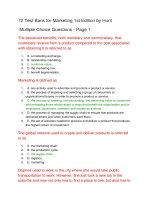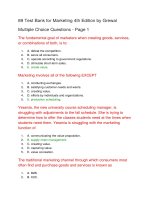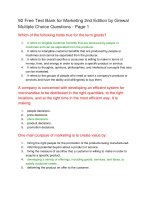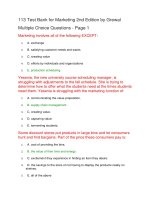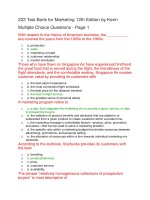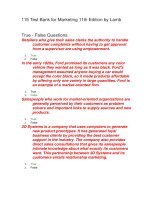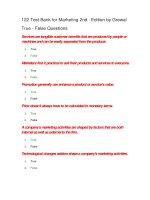72 test bank for marketing 1st edition by hunt
Bạn đang xem bản rút gọn của tài liệu. Xem và tải ngay bản đầy đủ của tài liệu tại đây (101.05 KB, 20 trang )
72 Test Bank for Marketing 1st Edition by Hunt
Multiple Choice Questions - Page 1
The perceived benefits, both monetary and nonmonetary, that
customers receive from a product compared to the cost associated
with obtaining it is referred to as
1.
2.
3.
4.
5.
A. a marketing exchange.
B. relationship marketing.
C. customer value.
D. the marketing mix.
E. benefit segmentation.
Marketing is defined as
1.
2.
A. any activity used to advertise and promote a product or service.
B. the process of targeting and selecting a group of consumers or
organizational buyers in order to promote a product or service.
3. C. the process of creating, communicating, and delivering value to customers
and managing those relationships in ways that benefit the organization and its
employees, customers, investors and society as a whole.
4. D. the process of managing the supply chain to ensure that products are
delivered where and when customers want them.
5. E. the set of activities needed to produce and deliver a product that produces
the highest return on investment.
The global network used to create and deliver products is referred
to as
1.
2.
3.
4.
5.
A. the marketing chain.
B. the production cycle.
C. the supply chain.
D. logistics.
E. marketing.
Daphne used to work in the city where she would take public
transportation to work. However, she just took a new job in the
suburbs and now not only has to find a place to live, but also has to
buy a car to get to and from her job. For Daphne, these things
represent
1.
2.
3.
4.
5.
A. a need.
B. a want.
C. a craving.
D. a dilemma.
E. a desire.
As it relates to customers, the aim of marketing is to
1.
2.
A. provide customers with value.
B. increase profits by ensuring customers pay the highest price possible for a
product.
3. C. accurately and truthfully advertise the product.
4. D. generate repeat sales from each and every customer.
5. E. reduce the number of customer complaints.
According to your text, what is the secret of great marketing when it
comes to creating value?
1.
2.
3.
A. convincing customers that they need a product even if they do not
B. consistently creating new products for the marketplace
C. figuring out how to charge the highest price for a product that customers
are willing to pay
4. D. understanding the marketplace demands before competitors do
5. E. saturating the market with all forms of advertising promotions
On a personal level, as you begin looking for a job after you
graduate, it will be critical for you to know how to
1.
2.
3.
4.
5.
A. deliver value.
B. market value.
C. explain value.
D. forecast value.
E. communicate value.
Which of the following would NOT be considered a member of a
supply chain?
1.
2.
3.
4.
5.
A. manufacturers
B. wholesalers
C. retailers
D. customers
E. shipping companies
Which of the following trends is accurate regarding the future of
marketing?
1.
A. The number of cable television subscribers has increased in recent years,
signaling to marketers that television advertising is still the preferred choice for
marketing products.
2. B. Information posed online in blogs and through websites has not proven to
be as successful as marketers thought since consumers often doubt the
accuracy of the information posted.
3. C. As technology impacts the business world, firms will need to explore new
models that address what customers want and how they prefer to receive
information.
4.
D. With the advent of technology, the basic goal of marketing has changed
from how to create, communicate, and deliver value to consumers to how to
better segment and target consumer markets.
5. E. Even though newspaper circulation has decreased in recent years, it is still
the preferred way to advertise because of its low cost.
Compare the following statements regarding relationship marketing
to determine which is MOST accurate?
1.
2.
3.
4.
5.
A. Relationship marketing is most successful when firms focus on attracting,
maintaining, and enhancing customer relationships.
B. Relationship marketing has waned as a viable strategy with the advent of
the Internet.
C. Relationship marketing focuses on satisfying the needs of all the company
stakeholders.
D. Relationship marketing is best described as the use of personal selling to
persuade consumers to buy products.
E. Very few companies in today's marketplace are engaged in relationship
marketing.
A local family is advertising a 5K run to raise awareness for autism
since one of their children suffers from the disorder. Salina likes to
run, so she decides to pay the fee to participate in the event.
Afterward, she is pleased that she went and felt good about helping
out the family. Would this be considered a marketing exchange?
1.
2.
A. No, because the consumer needs of Salina were not met.
B. Yes, because the family had to pay for advertising and therefore was
engaged in marketing.
3. C. No, because Salina did not receive anything for participating in the event.
4. D. Yes, because participating in the run was exchanged for Salina's feeling of
satisfaction for helping the family.
5. E. No, because the event involved a service but not a good.
The activity of buyers and sellers trading things of value so that
each is better off as a result is referred to as
1.
2.
3.
4.
5.
A. bartering.
B. an exchange.
C. personal selling.
D. a marketing interchange.
E. merchandising.
During what stage in the evolution of marketing did firms believe
that quality products would sell themselves?
1.
2.
3.
A. sales orientation
B. production orientation
C. marketing concept
4.
5.
D. relationship marketing
E. customer orientation
The Fantastically Fit health club has just opened a new location in
your neighborhood. The club has mailed a flyer to all households in
the area that contains information about the club and a coupon for a
one-month free membership. In doing so, Fantastically Fit is MOST
LIKELY attempting to
1.
2.
3.
4.
5.
A. explain value.
B. communicate value.
C. deliver value.
D. forecast value.
E. market value.
The focus of the marketing concept era was on
1.
2.
3.
4.
5.
A. production.
B. customers.
C. sales.
D. competition.
E. technology.
In marketing, states of felt deprivation are referred to as
1.
2.
3.
4.
5.
A. wants.
B. desires.
C. needs.
D. cravings.
E. opportunities.
In marketing, an exchange refers to
1.
2.
3.
A. the money paid by a consumer for a product or service.
B. replacing a non-effective form of advertising for a more effective one.
C. two people bartering products and services for other products and
services.
4. D. updating or replacing a non-profitable product in hopes of generating more
revenue.
5. E. buyers and sellers trading things of value so that each is better off as a
result.
In marketing terms, what is a person looking to satisfy if he or she
feels deprived of basic necessities such as food, clothing, shelter,
transportation or safety?
1.
2.
3.
4.
A. a need
B. a want
C. a craving
D. a dilemma
5.
E. a desire
According to your text, what is the most basic concept in
marketing?
1.
2.
3.
4.
5.
A. determining the difference between consumer needs and wants
B. determining the best advertising outlet for a product
C. streamlining production costs to generate maximum profits
D. satisfying the needs of stakeholders
E. getting all members of an organization to agree on a marketing plan
Marketers define customer value as
1.
2.
3.
4.
5.
A. providing a product at the lowest possible price after covering all production
expenses.
B. selling products that generate the least amount of customer returns or
complaints.
C. selling a product regardless of whether or not it meets a customer's needs
and/or wants.
D. providing a product or a service to a customer such that he or she will
purchase that same product or service again in the future.
E. the perceived benefits, both monetary and nonmonetary, that customers
receive from a product compared to the cost associated with obtaining it.
Compare the following statements to determine which one best
reflects the thinking behind the sales orientation era of marketing?
1.
2.
A. We need to find more efficient means of creating quality products.
B. Our entire company needs to be focused on satisfying our customers'
needs.
3. C. It's time we develop a strategy to attract and maintain more customers.
4. D. Our products are of such great quality, they practically sell themselves.
5. E. We'd better persuade our customers to buy our products or they will buy
from our competitors.
Which era in the history of marketing continued until the end of
World War II?
1.
2.
3.
4.
5.
A. production orientation
B. sales orientation
C. marketing concept
D. relationship marketing
E. customer orientation
After listening to customer requests for travel routes to the
Northwest, Southwest Airlines has added cross-country routes to
both Seattle and Portland. By providing its customers with benefits
that meet their needs, Southwest is providing
1.
A. customer value.
2.
3.
4.
5.
B. benefit marketing.
C. benefit segmentation.
D. a marketing mix.
E. customer service.
The process of planning, implementing, and controlling the flow of
goods, services and information between the point of origin and the
point of consumption in order to meet customer requirements is
called
1.
2.
3.
4.
5.
A. logistics.
B. production.
C. the supply chain.
D. operations.
E. marketing.
American clothing company manufactures clothes to be sold in
retail stores. After the clothing is manufactured, it is shipped to
wholesalers who, in turn, use transportation companies to ship the
product to various retail outlets. The manufacturer, wholesaler,
transportation company and retailer all work together to create and
deliver the product. This is an example of
1.
2.
3.
4.
5.
A. creating value.
B. communicating value.
C. delivering value.
D. forecasting value.
E. marketing value.
The era in the evolution of marketing when firms produced more
goods than they could sell and thus had to focus on effective sales
forces to find customers for their growing production capacity was
referred to as the
1.
2.
3.
4.
5.
A. sales orientation era.
B. relationship marketing era.
C. marketing concept era.
D. production orientation era.
E. customer orientation era.
What is the key to creating value?
1.
2.
3.
4.
5.
A. being the first to create a new product or service
B. providing consumers with benefits that meet their needs and wants
C. accurately advertising a product
D. making sure that products are priced lower than the competition
E. convincing consumers that they need a product, even if they do not
perceive that they do
Which marketing strategy was especially important during the Great
Depression when consumers did not have much money and firms
competed intensely for their dollars?
1.
2.
3.
4.
5.
A. customer orientation
B. production orientation
C. marketing concept
D. relationship marketing
E. sales orientation
Which of the following accurately depicts the stages in the evolution
of marketing?
1.
2.
3.
4.
5.
A. sales orientation, production orientation, marketing concept, relationship
marketing
B. production orientation, marketing concept, relationship marketing, sales
orientation
C. production orientation, sales orientation, marketing concept, relationship
marketing
D. marketing concept, production orientation, sales orientation, relationship
marketing
E. sales orientation, production orientation, relationship marketing, marketing
concept
What percentage of new products fail in the marketplace?
1.
2.
3.
4.
5.
A. 5 to 10 percent
B. approximately 25 percent
C. 50 percent
D. less than 3 percent
E. over 80 percent
What era in the history of marketing best reflects the idea that a
firm's long-term success must include a company-wide effort to
satisfy customer needs?
1.
2.
3.
4.
5.
A. marketing concept
B. production orientation
C. sales orientation
D. customer orientation
E. relationship marketing
Having an efficient supply chain is critical if a firm wishes to
1.
2.
3.
4.
5.
A. deliver value.
B. forecast value.
C. create value.
D. communicate value.
E. market value.
What is the premise behind the marketing concept?
1.
2.
3.
4.
5.
A. a company-wide focus on increasing profits
B. focusing on keeping the company stakeholders satisfied
C. an interest in streamlining production processes
D. a focus on satisfying the needs of the customer
E. utilizing all aspects of marketing to persuade consumers to buy
The marketing concept began to emerge in the
1.
2.
3.
4.
5.
A. 1920s.
B. 1930s.
C. 1950s.
D. 1970s.
E. 1990s.
Which era in the history of marketing began in the early years of the
United States and lasted until the mid-1920s?
1.
2.
3.
4.
5.
A. production orientation
B. sales orientation
C. marketing concept
D. relationship marketing
E. customer orientation
72 Free Test Bank for Marketing 1st Edition by Hunt
Multiple Choice Questions - Page 2
What term is used to describe the increasingly interconnected
nature of the world economy?
1.
2.
3.
4.
5.
A. globalization
B. internationalization
C. the marketing mix
D. relationship marketing
E. the worldwide web
Which marketing mix element is typically the easiest to change?
1.
2.
3.
4.
5.
A. product
B. price
C. place
D. promotion
E. perception
How many steps are there in the ethical decision-making
framework?
1.
A. five
2.
3.
4.
5.
B. eight
C. six
D. seven
E. ten
What is a firm concerned with when it focuses specifically on the
obligations an organization has to those who can affect whether or
not the firm achieves its objectives?
1.
2.
3.
4.
5.
A. employee morale
B. corporate social responsibility
C. shareholder responsibility
D. ethical marketing
E. stakeholder responsibility
Compare the following statements to determine which one
accurately describes the impact NAFTA has had on U.S. farmers.
1.
2.
3.
4.
5.
A. Because of the heavy regulations imposed on exports, farmers have
avoided exporting goods to participating NAFTA countries.
B. Because of the negative view of NAFTA in other countries, U.S. farmers
have found a difficult time getting their products shipped into those countries.
C. Even though NAFTA has relaxed trade restrictions, farmers have been
reluctant to ship products into other countries for fear of improper storage
and/or contamination of their product.
D. Even though farmers can now ship and sell their products to other
countries, the fees imposed for doing so have not allowed farmers to generate
any profit.
E. Because they have been able to ship and sell their produce to other
countries, NAFTA has given farmers the opportunity to expand their business
and increase profits.
What impact can a successful marketing campaign have on
nonprofit organizations?
1.
2.
A. It can help nonprofit organizations achieve a for-profit status.
B. It can help nonprofit organizations attract members and raise much-needed
funds.
3. C. It would have no impact since nonprofit organizations do not require
marketing campaigns.
4. D. It can allow nonprofit organizations to receive tax breaks from the
government.
5. E. It can help to increase revenue and profits for the firm.
Wants are the form that human needs take and are shaped by
1.
2.
3.
4.
A. time, money, and expense.
B. culture, money, and geography.
C. personality, culture, and buying situation.
D. lifestyle, demographics, and economic conditions.
5.
E. money, desire, and ability.
The four Ps are more formally referred to as the marketing
1.
2.
3.
4.
5.
A. dimensions.
B. concept.
C. framework.
D. matrix.
E. mix.
In an effort to help raise awareness of hunger in the United States,
Tyson Foods initiated the KNOW Hunger campaign to encourage
people to KNOW the scope of hunger in their own communities. As
part of this effort, Tyson has committed to donate one million
pounds of chicken to food banks around the country. These actions
by Tyson are an example of
1.
2.
3.
4.
5.
A. corporate social responsibility.
B. its marketing plan.
C. global marketing.
D. its marketing concept.
E. stakeholder responsibility.
Which marketing mix element involves decisions regarding logistics
and managing the supply chain?
1.
2.
3.
4.
5.
A. perception
B. price
C. place
D. promotion
E. product
The group of Internet-based applications that allow the creation and
exchange of user-generated content is called
1.
2.
3.
4.
5.
A. social media
B. web media
C. online applications
D. Internet marketing
E. network marketing
What is the first step in the ethical decision-making framework?
1.
2.
3.
4.
5.
A. identify the ethical issue at hand
B. identify the stakeholders impacted by the decision
C. consider how the issue will affect the stakeholders
D. determine the facts in an unbiased manner
E. discuss the issue with the stakeholders
What role, if any, did marketing play in the U.S. housing crisis that
began in December 2007?
1.
2.
3.
4.
5.
A. Marketers did not play a role in the housing crisis, as the problem was
between consumers seeking housing loans and the lenders who granted the
loans.
B. The housing crisis was triggered by marketers who took consumers' basic
need for a house and encouraged their want to buy a house that was more
than they could afford.
C. Marketers were responsible for not notifying the public that a crisis was
looming.
D. Marketers did not play a role in the housing crisis, because in the end,
consumers are ultimately responsible for the products they purchase.
E. Marketers acted unethically by only advertising bank loan rates in certain
areas of the country.
The combination of activities that represent everything a firm can do
to influence demand for its good, service or idea is referred to as
the marketing
1.
2.
3.
4.
5.
A. plan.
B. concept.
C. mix.
D. matrix.
E. model.
Which of the following products does NOT satisfy a consumer
need?
1.
2.
3.
4.
5.
A. a home security system
B. a winter coat
C. groceries
D. a house
E. cable television
Which marketing mix element describes what a buyer exchanges
with a seller?
1.
2.
3.
4.
5.
A. product
B. price
C. place
D. promotion
E. perception
NAFTA is an international trade agreement between the United
States
1.
2.
A. and Brazil.
B. Canada, and Mexico.
3.
4.
5.
C. China, and Japan.
D. and Great Britain.
E. India, and China.
Tony the Tiger and the slogan They're Great are elements that help
to identify Kellogg's _______ from that of its competitors
1.
2.
3.
4.
5.
A. brand
B. logo
C. patent
D. trademark
E. style
All of the following are considered to be external stakeholders of a
firm EXCEPT
1.
2.
3.
4.
5.
A. suppliers.
B. managers.
C. government.
D. customers.
E. shareholders.
According to your text, any discussion of the marketing mix typically
begins with the
1.
2.
3.
4.
5.
A. place.
B. price.
C. promotion.
D. consumers.
E. product.
The owners of Have It Your Way Hot Dogs have decided to place
an advertisement in the local minor league baseball team's program
booklet. Which element of the marketing mix does this represent?
1.
2.
3.
4.
5.
A. purpose
B. price
C. place
D. promotion
E. product
As noted in your text, what was the result when some of the world's
most ethical companies were compared to the S&P 500 index on a
profitability measure?
1.
A. The firms that were identified as ethical were more profitable initially, but
then showed a pattern of declining profitability compared to the mix of
companies included in the S&P 500 index.
2. B. The firms that were identified as ethical were significantly less profitable on
the whole than the mix of companies included in the S&P 500 index.
3.
C. The firms that were identified as ethical were more profitable on the whole
than the mix of companies included in the S&P 500 index.
4. D. The firms that were identified as ethical were not as profitable initially, but
then showed a pattern of unprecedented profit increase when compared to the
mix of companies included in the S&P 500 index.
5. E. The firms that were identified as ethical were equally profitable on the
whole to the mix of companies included in the S&P 500 index.
Your text defines ethics as moral standards expected by
1.
2.
3.
4.
5.
A. an organization.
B. a society.
C. the AMA.
D. employees.
E. consumers.
According to your text, taking a marketing course can help your
career in all of the following ways EXCEPT
1.
2.
3.
A. by helping you market yourself to get a job after college.
B. by helping you reach professional goals.
C. by helping you position yourself relative to others competing for the same
job.
4. D. by helping you communicate your value so that you get an interview.
5. E. by helping you determine what career field you should enter.
Which of the following questions would a firm ask if it were using
the ethical decision-making framework regarding its product?
1.
2.
3.
4.
5.
A. Are the relationships between wholesalers and retailers inappropriate?
B. Does the advertising message represent the product's benefits honestly?
C. Should the firm increase prices due to a lack of local competition?
D. What default privacy settings should be built into a website?
E. Does the advertising message attack competing products rather than
highlight the benefits of the firm's product?
Which of the following is NOT one of the ethical norms spelled out
in the AMA's Code of Ethics?
1.
2.
3.
4.
5.
A. transparency
B. fairness
C. citizenship
D. balance
E. honesty
Think about the ethical values set forth in the AMA's code of ethics.
Which value is represented when a firm accepts constructive
criticism from customers and other stakeholders?
1.
A. honesty
2.
3.
4.
5.
B. fairness
C. responsibility
D. respect
E. transparency
The name, term, symbol, design, or any combination of these that
identifies and differentiates a firm's products is known as its
1.
2.
3.
4.
5.
A. trademark.
B. patent.
C. brand.
D. logo.
E. identifier.
What step in the ethical decision-making framework is sometimes
referred to as seeing through a problem to the other side?
1.
2.
3.
4.
5.
A. consider how the decision will affect the stakeholders
B. identify the ethical issue at hand
C. discuss the pending decision with the stakeholders
D. consider all available alternatives
E. make the decision
What type of marketing strategy is a company using if it consciously
addresses customers, markets, and competition throughout the
world?
1.
2.
3.
4.
5.
A. an import/export strategy
B. a global marketing strategy
C. a domestic market strategy
D. a foreign investment agreement
E. an international trade agreement
All of the following are elements contained in the 4 Ps of the
marketing mix EXCEPT
1.
2.
3.
4.
5.
A. price.
B. promotion.
C. profit.
D. place.
E. product.
In ethical decision-making, what element of the marketing mix is
affected when a firm is deciding whether or not to outsource jobs to
other members of the supply chain?
1.
2.
3.
A. product
B. price
C. place
4.
5.
D. promotion
E. profitability
Compare the following definitions and select the one which
accurately defines the term corporate social responsibility.
1.
2.
3.
4.
5.
A. an organization's responsibility to balance the desire for profit with the cost
of having to employ people
B. any charitable measure taken by a firm that benefits society as a whole
C. an organization's responsibility to provide a good product at a fair price
D. an organization's obligation to maximize its positive impact and minimize its
negative impact on society
E. an organization's obligation to benefit those who impact its ability to
achieve its objectives
Which of the following accurately represents the 4 Ps of the
marketing mix?
1.
2.
3.
4.
5.
A. product, price, promotion, and perception
B. production, promotion, profit, and participation
C. promotion, place, profit, and preference
D. product, price, place, and promotion
E. perception, preference, participation, payment
What type of need is shaped by personality, culture, or buying
situation?
1.
2.
3.
4.
5.
A. a craving
B. a want
C. a demand
D. a necessity
E. an emergency
Which of the following questions relates to the place element of the
marketing mix?
1.
2.
3.
4.
5.
A. How long has my product existed?
B. How much inventory should I have?
C. Should I offer customers a discount?
D. Do I need to hire salespeople?
E. How do I want the public to view my product?
Initiatives such as creating corporate charitable foundations,
supporting minority activities and demanding responsible business
practices throughout the organization are all examples of
1.
2.
3.
4.
A. stakeholder responsibility.
B. social marketing efforts.
C. corporate social responsibility.
D. global marketing.
5.
E. logistics.

